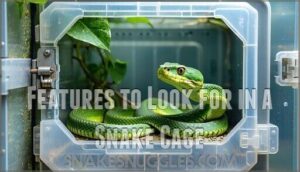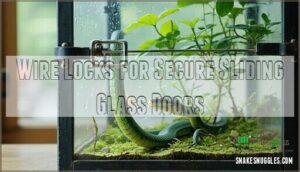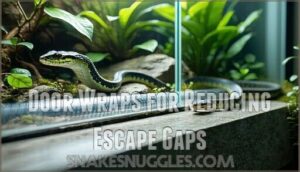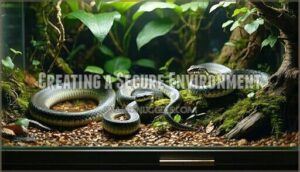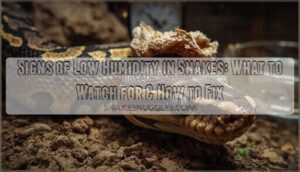This site is supported by our readers. We may earn a commission, at no cost to you, if you purchase through links.
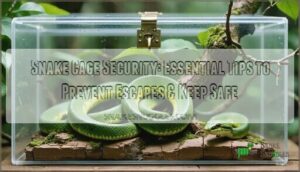
You’ll want secure, lockable lids and doors that can’t be pushed open by your snake’s surprising strength. Check regularly for cracks, gaps, or weak spots where your slithery friend might attempt a great escape.
Wire locks work well for sliding doors, while door wraps help eliminate those sneaky gaps snakes love to exploit. Don’t forget proper ventilation that won’t compromise security.
Even the most docile snake becomes Houdini when freedom calls, so investing in quality hardware and performing routine inspections keeps everyone safe. The right setup involves more than just a sturdy box.
Table Of Contents
- Key Takeaways
- Securing Your Snake’s Home
- Choosing The Right Snake Cage
- Safety Features for Snake Enclosures
- Creating a Secure Environment
- Additional Security Measures
- Snake Cage Security Essentials
- Frequently Asked Questions (FAQs)
- How to secure a snake tank?
- Can snakes escape a cage?
- How to protect a dog cage from snakes?
- How to secure a snake cage?
- How to snake proof an enclosure?
- What not to put in a snake enclosure?
- Should snakes be kept in cages?
- What size cage does my snake need?
- Are there legal requirements for owning a venomous snake?
- What accessories do I need for my snakes cage?
- Conclusion
Key Takeaways
- Choose escape-proof enclosures – You’ll need tempered glass or heavy-duty plastic cages with secure, lockable lids that can’t be pushed open by your snake’s surprising strength.
- Install proper security hardware – Use wire locks for sliding doors, door wraps to eliminate gaps, and solid grommets instead of standard wire ones to block all potential escape routes.
- Perform regular maintenance checks – You should inspect your enclosure weekly for cracks, gaps, or weak spots, testing all locks and latches to catch problems before your snake finds them.
- Add backup security measures – Consider magnetic door alarms or smart sensors that’ll alert you instantly if your snake’s enclosure is compromised, giving you peace of mind even when you’re away.
Securing Your Snake’s Home
Your snake’s safety depends on a secure enclosure that prevents escapes and protects both you and your pet.
Even the most docile snake can become an escape artist if given the chance, so proper cage security isn’t just recommended—it’s essential.
Escape-Proof Enclosures for Venomous Snakes
In regards to venomous containment, every detail matters. Three critical secure materials and locking mechanisms form your first line of defense against potential disasters.
Wire locks are your best friend for sliding glass doors. These simple yet effective devices prevent accidental openings that could spell trouble. Think of them as insurance for your peace of mind – they require deliberate human action to open, not just a curious snake’s nudge.
Door wraps tackle those sneaky gaps between sliding panels. Even the tiniest opening becomes an escape route for determined snakes. These additions minimize space while preventing door warping over time, maintaining your ventilation security without compromising safety.
Solid grommets replace standard wire versions, eliminating potential escape routes through ventilation holes. It’s amazing how snakes can squeeze through spaces that seem impossibly small. For temporary holding and transport, consider a safety snake bucket.
Together, these durable design features create truly escapeproof enclosures. Your snake cage security depends on this trinity of protection. Remember, snake escape prevention starts with choosing the right secure snake habitat from day one.
Importance of Responsibility in Snake Ownership
In the context of snake ownership responsibility, you’re stepping into territory that demands serious commitment. This isn’t like caring for a goldfish – snake safety requires constant vigilance and genuine expertise.
Ethical Considerations and Owner Competence go hand in hand:
- Proper training before acquiring any venomous species
- Creating secure, escape-proof environments with locked rooms
- Using specialized handling tools to minimize direct contact
- Regular enclosure inspections and maintenance schedules
- Understanding your snake’s behavior and escape tendencies
Responsible snake keeping means accepting that your actions affect Public Safety. Every security measure you implement protects not just your family, but your entire community. Snake escape prevention starts with acknowledging that these animals are persistent escape artists who’ll exploit any weakness in their housing.
Your role extends beyond basic care – you’re a guardian ensuring Conservation Impact through ethical practices. This responsibility shapes every decision, from enclosure design to daily handling protocols, making snake ownership a serious commitment.
Legal Considerations for Venomous Snake Owners
Your local laws might surprise you – permit requirements vary wildly across states.
Some ban venomous snakes entirely, while others need species restrictions documentation and facility inspections.
Local ordinances can trump state laws, so check city regulations too.
Florida demands 1,000 experience hours and reference letters.
Liability insurance protects against escape-related damages.
In Pennsylvania, a permit is needed to manage timber rattlesnakes.
Don’t skip this step – venomous legality violations bring hefty fines and animal confiscation.
Choosing The Right Snake Cage
You’ll need the right cage to keep your snake safe and secure.
The wrong choice can turn your pet into an escape artist faster than you can say "where’d it go?
Features to Look for in a Snake Cage
Now that you’ve secured your snake’s home, let’s talk about what makes a good cage. Think of it as shopping for an apartment – you wouldn’t pick just any place, right?
Size Requirements matter most. Your snake needs room to stretch out completely and turn around without feeling cramped. Picture trying to live in a closet – not fun for anyone.
Ventilation Needs keep your pet healthy. Look for perforated vents that allow fresh air while preventing escapes. Good airflow stops humidity buildup and keeps things fresh.
Durable Materials like high-density polyethylene resist damage and make Cleaning Ease simple. You’ll thank yourself later when maintenance becomes a breeze instead of a headache.
Locking Mechanisms aren’t optional – they’re your first line of defense. Snakes are escape artists who’ll exploit any weakness. Quality locks prevent both accidents and determined breakout attempts.
Here’s your shopping checklist:
- Escape-proof design with minimal gaps
- Reptile enclosure built specifically for snakes
- Snake cage security features like reinforced doors
- Tempered glass or wire mesh options
- Easy-access feeding doors
Benefits of Vision Cages for Reptiles
When you’ve narrowed down your cage options, Vision Cages stand out as a top choice for snake owners who prioritize safety and convenience. These reptile enclosures offer several advantages that make snake keeping more manageable.
Durability and Longevity shine through Vision Cages’ single-piece HDPE construction. This material resists impacts, chemicals, and high temperatures—meaning your investment lasts decades. Many owners report using the same cage for over 20 years.
Here’s why Vision Cages excel for your reptile habitat:
- Stackable Design saves precious room space when housing multiple snakes
- Cleaning Ease with seamless shells that prevent bacteria buildup
- Customizable Habitat options supporting various temperature and humidity zones
- Reptile Safety through tempered glass doors and rust-resistant aluminum tracks
The secure reptile enclosure design accommodates heat lamps, misters, and other accessories without compromising structural integrity. Whether you’re breeding snakes or keeping a single pet, these cages adapt to your specific needs while maintaining the security that prevents those heart-stopping escape scenarios every snake owner dreads.
How to Select The Right Cage for Your Snake
Choosing the right snake cage requires careful consideration of your specific snake species and their unique needs.
Start by measuring your snake’s length to determine proper cage dimensions.
| Factor | Small Snakes | Large Snakes |
|---|---|---|
| Cage Material | Plastic, glass | Heavy-duty plastic |
| Ventilation Needs | Standard vents | Multiple air sources |
| Size Matters | 20-40 gallons | 75+ gallons |
| Locking Mechanisms | Basic latches | Heavy-duty locks |
| Snake Species | Corn, ball python | Boa, python |
Your reptile enclosure should allow full body extension plus turning space.
Consider escape prevention features like secure locking mechanisms and proper cage design for your snake’s strength level.
Safety Features for Snake Enclosures
When your snake tests every corner of its enclosure for weaknesses, specific safety features become your first line of defense against escapes.
Wire locks, door wraps, and solid grommets work together to eliminate the gaps and openings that even the most determined escape artist can’t exploit.
Wire Locks for Secure Sliding Glass Doors
Vigilance stands as your first line of defense against snake escapes. Wire locks transform ordinary sliding glass doors into fortress-like barriers that keep your serpent safely contained.
These essential locking mechanisms attach directly to your enclosure’s sliding glass doors, creating an extra security layer that prevents accidental openings.
1. Lock Installation and Durability: Wire locks install easily on most sliding glass doors. Check installation tips from manufacturers and inspect your lock materials regularly for wear or damage.
2. Lock Strength: These locks withstand persistent pushing from determined snakes. Quality wire locks resist the surprising strength snakes can exert against enclosure barriers.
3. Snake Cage Features: Choose enclosures with wire locks as standard equipment. This sliding security feature should complement other escape prevention measures in your setup.
Regular lock maintenance guarantees your wire locks continue protecting your snake.
You can find various wire lock models online. Alternative locks exist, but wire locks remain the gold standard for snake cage security on sliding doors.
Door Wraps for Reducing Escape Gaps
How can you keep your snake from squeezing through those pesky door gaps? Door wraps provide your answer.
These flexible strips attach along door edges with strong adhesive, creating a tighter seal. They’re your first line of defense against sneaky escape artists who’d otherwise slip through minimal openings.
| Wrap Materials | Installation Benefits |
|---|---|
| Flexible rubber strips | Easy adhesive application |
| Weather-resistant foam | Long-term durability guaranteed |
| Custom-cut vinyl | Perfect gap minimization |
Super glue ensures adhesive strength that lasts. To prevent escapes, it’s also important to verify proper ventilation levels. This escapeproof design upgrade transforms any locking snake cage into a fortress, giving you peace of mind while maintaining your snake’s security.
Solid Grommets for Eliminating Escape Routes
You’ll find solid grommets are game-changers for snake cage security. Standard wire grommets create obvious escape routes that clever snakes exploit during escape attempts.
Grommet materials matter—solid versions block these gaps completely. Size matters too; choose grommets that fit your enclosure’s holes perfectly.
Installation techniques are straightforward: remove old wire grommets and press in solid replacements. Grommet alternatives include plugs or covers.
Long-term durability means fewer snake escapes and better escapeproof design. This simple upgrade transforms vulnerable spots into secure barriers.
Creating a Secure Environment
You’ll need to stay on top of regular cage inspections and maintenance to catch potential security issues before your snake finds them.
Creating the right environment isn’t just about keeping your snake inside—it’s about making sure they’re comfortable and stress-free in their secure home.
Importance of Regular Enclosure Maintenance
Beyond the basics of snake cage security, consistent maintenance forms the backbone of a truly secure enclosure.
Think of it as your snake’s insurance policy against both escape and health issues. Regular upkeep isn’t just about cleanliness—it’s about spotting problems before they become dangerous.
Your maintenance routine should include these essential checks:
- Latch integrity – Test all locks and latches weekly to confirm they’re functioning properly
- Grommet condition – Inspect grommets for wear that could create new escape routes
- Material degradation – Look for cracks, warping, or weakening in cage walls and doors
- Ventilation checks – Clean vents and verify proper airflow without compromising security
- Sealant inspection – Check door seals and joints for gaps that snakes might exploit
Snake cage maintenance isn’t glamorous, but it’s critical for snake wellbeing and your peace of mind. A weekly inspection takes just minutes but prevents costly escapes and protects your snake’s health. Regular snake cage cleaning also helps you notice changes in your pet’s behavior or appetite early.
Ensuring a Stress-Free Environment for Your Snake
A stress-free environment starts with proper Enclosure Size – your snake needs room to stretch and explore.
Temperature Gradient and Humidity Control create comfort zones, while smart Substrate Choice prevents respiratory issues.
Hiding Spots and snake enrichment reduce anxiety.
Snakes in a yard can offer natural pest control.
| Stress Factor | Snake’s Reaction | Your Solution |
|---|---|---|
| Too bright/exposed | Constant hiding, poor appetite | Multiple hiding spots, dim lighting |
| Wrong temperatures | Sluggish or hyperactive behavior | Proper temperature gradient setup |
| High traffic noise | Defensive posturing, stress shedding | Quiet location, consistent routines |
This snake habitat foundation supports both snake wellbeing and snake cage security.
Additional Security Measures
Even the most secure cage can benefit from backup systems that alert you to potential problems.
Modern technology offers smart sensors and alarms that can notify you instantly if your snake’s enclosure is compromised, giving you peace of mind whether you’re home or away.
Magnetic Door Window Alarms for Added Security
Magnetic door alarms provide an extra security layer for snake cage monitoring.
These battery-powered devices detect unauthorized access and escape attempts through instant notifications when doors open unexpectedly.
Consider purchasing reliable alarm systems for superior protection.
Alarm Installation and sensor placement considerations:
- Battery Life – Choose alarms with long-lasting batteries and low-battery alerts for reliable remote monitoring
- Sensor Placement – Position sensors on cage doors, room entrances, or enclosure access points for thorough coverage
- System Integration – Select alarms compatible with your home security setup for seamless snake enclosure security
- Remote Monitoring – Opt for wireless models that send alerts directly to your phone for immediate response
Geeni Smart Door Window Sensors for Snake Owners
Two smart options protect your snake cage from unauthorized access and potential escapes.
The Geeni Smart Door Window Sensor provides advanced snake cage security through reliable real-time alerts and remote monitoring capabilities. This wireless device connects to your 2.4 GHz Wi-Fi network without requiring a hub, making Geeni Setup straightforward for any reptile keeper.
The magnetic sensor placement involves attaching one component to your enclosure frame and another to movable doors. When separated, you’ll receive instant smartphone notifications about escape attempts.
Key benefits include:
- Remote monitoring: Track your enclosure’s security status from anywhere globally
- Battery life: Replaceable AAA batteries provide 6-12 months of continuous operation
- Smart door window sensors: 80-decibel siren deters tampering while alerting you immediately
This technology transforms traditional snake escapes from undetected disasters into manageable situations with immediate awareness.
Customizing Your Snake Cage for Maximum Security
Smart door sensors offer peace of mind, but you can take snake cage security measures even further with custom modifications. Your snake’s safety depends on thinking like an escape artist and blocking every possible route.
Cage modifications work wonders when you add customized locks or interior barriers. Replace standard wire grommets with solid ones to eliminate tiny escape routes. Create hiding places that double as security checkpoints—your snake gets enrichment toys while you get added protection.
DIY security lets you build snake enclosure security measures that fit your specific setup. Consider cage camouflage techniques that hide locking mechanisms from curious hands while keeping them accessible for maintenance.
Escape-proof design means examining every corner, joint, and opening. Snake cage locking mechanisms should complement your cage’s natural strengths, not fight against them.
Here’s what drives most snake owners to customize:
- The sinking feeling when you discover an empty cage
- Sleepless nights wondering if your snake’s truly secure
- The relief of knowing you’ve covered every angle
Snake Cage Security Essentials
Once you’ve secured your snake’s enclosure with proper locks and escape-proof features, you’ll need the right bedding and heating elements to complete a safe habitat.
These essentials work together to create an environment that keeps your snake comfortable while maintaining the security measures that prevent dangerous escapes.
Bedding and Accessories for a Secure Snake Cage
Bedding choices affect your snake’s comfort and your cage’s security. Safe Substrates like cypress mulch or paper towels won’t harbor bacteria or create escape opportunities.
Hides and Security matter too—choose sturdy options that won’t tip over. Water Bowl Security prevents spills that weaken locks, while proper Enrichment Options keep snakes content without compromising safety.
Many keepers prioritize using appropriate snake bedding for their reptiles.
| Accessory Type | Security Feature |
|---|---|
| Snake bedding | Non-particle substrates prevent impaction |
| Snake hides | Weighted bases prevent tipping |
| Snake water bowls | Heavy ceramic won’t slide around |
| Snake accessories | Smooth edges eliminate injury risks |
| Snake cage substrate choice | Easy-clean materials support Cleaning Protocols |
Heat and UV-B Light Sources for a Safe Environment
Beyond proper bedding, you’ll need the right heat sources to keep your snake healthy and secure.
Heat gradients let your snake regulate its body temperature naturally, while proper UVB light supports bone health.
Here’s what you need for safe heating and lighting:
- Basking spots with thermostat control prevent overheating and burns
- Heat penetration through ceramic heaters maintains consistent temperatures without fire risks
- Light cycles mimic natural day/night patterns for better snake behavior
- UV-B intensity should match your species’ needs without creating hot spots
- Airflow around heat sources prevents oxygen depletion and maintains air quality.
To maintain ideal conditions, consider that heat mats offer consistent bottom heat.
Frequently Asked Questions (FAQs)
How to secure a snake tank?
Jake’s ball python escaped through a tiny gap in his terrarium lid, hiding for weeks before being found dehydrated.
You’ll need secure locks, eliminate gaps, use clamps on screen tops, and regularly inspect all latches and openings.
Can snakes escape a cage?
Yes, snakes can definitely escape cages if they’re not properly secured.
They’re surprisingly strong and persistent, exploiting any opening larger than their head to squeeze through and make their great escape.
How to protect a dog cage from snakes?
Like a fortress protecting its treasure, you’ll need to secure your dog’s outdoor area with snake-proof fencing.
Remove hiding spots, and install fine mesh barriers around the cage perimeter to keep slithering intruders out.
How to secure a snake cage?
Use wire locks on sliding doors, door wraps to minimize gaps, solid grommets instead of standard ones, and secure locking mechanisms.
Make certain proper ventilation with escape-proof openings smaller than your snake’s head, ensuring secure locking is not the only consideration.
How to snake proof an enclosure?
Install wire locks on sliding doors, use solid grommets instead of standard ones, add door wraps to minimize gaps, make secure latches, and inspect regularly for escape routes.
What not to put in a snake enclosure?
Sharp corners become deadly traps—avoid glass tanks, wire grommets, and unsecured objects. Don’t include items with gaps, rough edges, or anything your snake’s head can squeeze through.
Should snakes be kept in cages?
Yes, you should keep snakes in properly designed enclosures.
Secure cages prevent escapes, protect your snake from household dangers, and guarantee safety for family members and pets while providing controlled environmental conditions.
What size cage does my snake need?
Your snake needs a cage where it can stretch out completely and comfortably turn around.
The combined length and width should equal your snake’s total body length for proper movement and well-being.
Are there legal requirements for owning a venomous snake?
Before diving into permits and licenses, consider that laws vary substantially by country, state, county, and city. Most jurisdictions require expensive yearly-renewed permits with strict qualifications for venomous species.
What accessories do I need for my snakes cage?
You’ll need secure locks, wire door guards, solid grommets for ventilation holes, door wraps to eliminate gaps, proper heating elements, and stackable cage systems for organization and safety.
Conclusion
Some people think snake cage security is overkill, but one escape can turn dangerous quickly.
Your snake’s safety depends on solid security measures you’ve implemented consistently, including quality locks, regular inspections, and proper ventilation.
These elements create the foundation for responsible ownership, and additional measures like smart sensors and door wraps add extra protection layers.
Remember, even docile snakes become escape artists when opportunity strikes, and investing in proper snake cage security protects your pet, your family, and your community from potential risks.
- https://www.zenhabitats.com/blogs/reptile-care-sheets-resources/3-simple-tips-on-keeping-your-pet-snake-secure-in-a-zen-habitats-enclosure
- https://familysnake.com/guides/snake-proof-your-enclosure-top-tips-for-preventing-slithery-escapes/
- https://www.scielo.br/j/jvatitd/a/d8t6MN65GfwtY9QRVmLHSPC/?format=html
- https://reptizoo.store/blogs/reptizoo-reptiles-blogs/how-to-choose-a-snake-enclosure
- https://pmc.ncbi.nlm.nih.gov/articles/PMC8160691/

